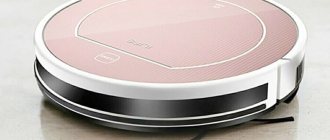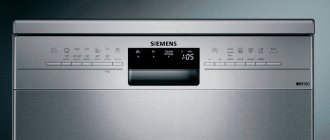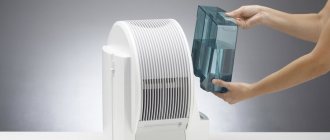Most people believe that the differences between freestanding and built-in dishwashers are insignificant. However, in practice, once you understand the technical characteristics of these two types of dishwashers, you can see specific differences.
Built-in appliances are more practical and versatile in terms of ventilation and thermal insulation.
This applies to any equipment where heating takes place, which involves increasing the temperature of the water.
When manufacturing free-standing dishwashers, such technological solutions are not provided. This is due to the fact that they are not covered by a furniture facade, and can be installed on any free area of the kitchen.
A freestanding and built-in machine differs from each other in appearance, dimensions, box capacity and the number of additional functions.
Rating of the TOP 13 best freestanding dishwashers of 2020-2021
| Place | Name | Price |
| TOP 5 narrow freestanding dishwashers (45 cm) | ||
| 1 | Bosch Serie 2 SPS25FW11R | Find out the price |
| 2 | Candy CDP 2L952 W | Find out the price |
| 3 | Midea MFD45S500 | Find out the price |
| 4 | Hotpoint-Ariston HSFC 3M19 C | Find out the price |
| 5 | HIBERG F48 1030 W | Find out the price |
| TOP 5 full-size freestanding dishwashers | ||
| 1 | Bosch Serie 4 SMS44GI00R | Find out the price |
| 2 | Electrolux ESF 9526 LOX | Find out the price |
| 3 | Hotpoint-Ariston HFC 3C26 | Find out the price |
| 4 | Indesit DFG 26B10 | Find out the price |
| 5 | Indesit DFG 15B10 | Find out the price |
| TOP 3 compact freestanding dishwashers under the sink | ||
| 1 | Candy CDCP 8/E | Find out the price |
| 2 | Weissgauff TDW 4017 D | Find out the price |
| 3 | Hotpoint-Ariston HCD 662 | Find out the price |
About
Where to place the outlet for the dishwasher
A high-quality socket is a very important element of proper installation of the dishwasher. If it is not possible to make a special socket for such equipment, at least replace or check how reliable the existing socket is. If it sparks, repair is necessary. The ideal option is to specifically draw a separate line from the shield so that the machine has its own automatic machine.
We list where to install the outlet for the dishwasher:
- The easiest option is behind the kitchen cabinets. The dishwasher is constantly connected to the network, so you do not need to see this outlet, it can be hidden;
- the minimum distance from the floor to the socket should be 10 cm, the maximum - 50 cm;
- If you already have sockets for appliances in the kitchen, it is better to make them all at the same height. Below there will be slots for a refrigerator, oven, dishwasher, above the work surface - for a microwave, blender and other small appliances, on top - for an extractor hood, lighting;
- It is advisable to immediately take into account how long the power cord of your equipment is. The result of thinking about where to make an outlet for a dishwasher largely depends on this.
Do not forget that all work with electricity requires certain skills and knowledge. It is important to install the socket taking into account the rules and regulations of the PUE, GOST, SP. Violation of standards can cause equipment breakdown, fire and other problems.
Advice: Never connect a dishwasher or oven through adapters or extension cords! Is it dangerous!
Advantages and disadvantages of freestanding dishwashers
Free-standing dishwashers can be characterized by a number of advantages, such as:
- Cleaning efficiency . The dishwasher will help you quickly deal with both fresh dirt and old ones equally effectively.
- Saving resources . Using a car is, first and foremost, saving money. Having purchased such equipment, you will immediately notice lower consumption of water and electricity, compared to manual washing. In addition, the machine will save your time, which is also important.
- You don’t have to stand and control the process so as not to flood your apartment and not “wash away” your neighbors’ renovations. Modern dishwashers are equipped with an automatic water blocking function immediately after washing and drying. The AquaStop function is active even when the equipment is idle.
- longer have to worry that your child will accidentally press something and the device will malfunction. Almost all models have a child lock feature.
Alas, free-standing dishwashers have not only positive aspects, but also negative ones:
- To increase the service life of the dishwasher, it is necessary to regularly clean the parts;
- you need to buy special detergents for the machine, which entails additional costs;
- Products made of copper, tin and wood should not be washed in the dishwasher; it is also undesirable to wash antique or especially valuable products in it, in order to avoid deformation.
About
And as a summary
We offer you a list of characteristics of an ideal dishwasher that will last a long time and will delight you with the consistently brilliant results of its work.
- A model from a reliable manufacturer who has been producing this type of equipment for many years and offers its own developments. For example: Bosch, Electrolux, Gorenje, Hotpoint, Beko and others. Preferably European assembly.
- Energy class A and higher.
- Washing and drying efficiency class not lower than A.
- Mandatory presence of a leakage protection system and an internal chamber made of stainless steel.
- Electronic control with basic temperature modes and additional programs: half load, accelerated mode.
- Light indication - “beam on the floor” or “display projection on the floor”.
- Drying is condensation or active condensation, as they are the most effective.
Welcome to our catalog! Happy shopping and good mood!
Which is better - built-in or free-standing?
Comparing a built-in and freestanding dishwasher, we can say for sure that they are no better or worse than each other.
When choosing such equipment, first of all, you should consider the installation location.
If you are planning a kitchen from scratch, then it is better to give preference to a built-in machine, which can be hidden behind a furniture facade, saving as much free space as possible. If the kitchen is already ready and you want to purchase a dishwasher, pay attention to the free-standing option. This will allow you to install the equipment in any place where there is enough space for it, and not destroy existing repairs and furniture for installation.
Also, free-standing machines are an excellent option for kitchens with a large area, where there is enough space to place appliances.
About
Types of dishwashers
A dishwasher is an indispensable device in a modern kitchen, which saves time, nerves and protects the skin of your hands. Thanks to this, the “washing assistant” is gaining popularity every year.
The first thing you should know about dishwashers before going to the store is what options there are and how they differ. There are three types of dishwashers:
- Tabletop models. Due to their small size, these machines can be installed directly on a table surface. This saves a lot of space in the bottom drawers.
- Stationary, separate model. Its advantages are that it can be installed without being tied to desk drawers. It does not need fixation or any additional attributes. To operate, you only need access to power and running water.
- Built-in models. When installing these dishwashers, a large number of questions arise. However, a number of significant advantages force buyers to pay attention to this type.
The love for built-in household appliances, especially dishwashers, can be explained very simply. They fit easily into the interior, do not take up additional space, are medium in size, and are safe to use.
[custom_ads_shortcode2]
How to choose and what to pay attention to?
Just before purchasing a dishwasher, consider such important points as:
- capacity of the box for dishes . The maximum capacity of dishwashers is 14 full sets of dishes, the minimum is 3-4. Capacity is selected depending on the number of people in the family and the frequency of use of the equipment. The more people in the family, the larger the dimensions of the box should be;
- water consumption . On average, equipment consumes 7-10 liters of water per washing cycle, depending on the selected washing program and the dimensions of the device;
- energy efficiency class . Do not ignore this parameter, since it determines the size of your utility bill. The optimal marking option for this parameter is A, A+, A++.
You should pay attention to the control panel. It can be of an open type, located on the front side of the machine facade, or closed, and located inside, on the upper end of the door.
The advantage of the first option is that you can always see all the parameters on the electronic display. The second option has a more stylish and modern look, ideal for modern kitchens that feature minimalism and hi-tech.
Another important point when choosing a dishwasher is its functionality.
Each model from a trusted manufacturer with high-quality assembly and good characteristics should have at least 5 basic modes for washing dishes:
- economical – a mode that consumers use almost every day. It is ideal for light to medium soiled dishes. A characteristic feature of the mode is rinsing at a temperature of 35 degrees, washing at 50. This mode will help save all resources and costs to the maximum;
- delicate – suitable for washing glass, porcelain and other types of fragile items. The water temperature during rinsing is 55 degrees, during washing – 40;
- intensive , suitable for old and heavily soiled cutlery and crockery. Temperature range 65-70 degrees;
- automatic . Its effective operation is due to the presence of special sensors that independently determine the degree of contamination of the dishes and select the optimal mode for their ideal cleaning. A characteristic feature of the program is the water temperature from 45 to 65 degrees;
- fast - the best option for dishes with “fresh” stains, or for giving dishes “freshness” before setting the table.
Manufacturers often equip modern dishwashers with two additional modes:
- night – mode with minimal noise during operation;
- half load – the ability to turn on equipment without a full load.
About
Temporary connection for dishwasher
Now let's figure out how to install a built-in dishwasher separately from the furniture set.
- First you need to connect the drain hose to the sewer. To do this, you can connect it to a part of the sink drain, which in turn connects to the sewer pipe. In this case, it is important to create a bend near the “joining” point so that waste waste does not linger in the hose. As a last resort, you can simply leave the drain hose in the sink.
- Make sure that the length of the drain hose is no more than 1.5. In extreme cases, you can leave 2m.
- Now you need to deal with the inlet hose. In order to install it, you must first install a special hose tee. Remove the faucet hose from the water supply and replace it with a brass or bronze adapter. Now install the mixer on one branch, the filter on the second, and the dishwasher hose on the third.
Attention! The last step is connecting to the network. At first, you can use an adapter, but when the unit is already built-in, it must be connected to a moisture-resistant outlet connected to a line protected by a circuit breaker.
Now you know how to operate your dishwasher without having to build it in until the kitchen furniture arrives. Try out new equipment and get out of the habit of washing dishes by hand.
Built-in appliances have already become firmly established in modern everyday life and are used in almost any kitchen. This is not only stylish, but also practical - you can significantly save useful space and, if necessary, hide household appliances.
Dishwashers are quite impressive in size, so they are most often built into furniture. In this case, the appearance of the equipment will depend on the facade of the cabinet.
Types of machines by installation method
All dishwashers that can be found on sale are divided into the following types:
- fully built-in;
- partially built-in;
- free-standing;
- desktop
All machines perform the same functions; the choice of type of equipment depends on your preferences and the existing interior of the kitchen.
Fully built-in machines
In this case, the device is installed in one of the niches of the kitchen unit and hidden behind a decorative facade, so only the owners of the house will know about its presence. The control panel for such models is located on the end of the door.
If you decide to choose a built-in dishwasher, then this is the best option, since the equipment is aesthetically pleasing and safe. The device does not interfere with the kitchen design concept, and its operation cannot be affected by children, since all controls are hidden behind the door.
Partially built-in machines
The difference from the previous version is only in the location of the equipment controls - they are located on the front panel, and not hidden behind the front door. However, such models also do not violate the style of the room, since the remaining part is designed to match the color and texture of the kitchen unit. The installation method is still the same - in a pre-prepared niche.
Freestanding machines
The device will look appropriate in a spacious room. The advantage of this technology is mobility. You are not limited in the choice of options for the location of the PMM and can experiment with rearranging furniture. The only caveat is that you will have to worry in advance about selecting the device in the desired shade to match the color of the headset. However, this is not a problem, since manufacturers offer a large selection of colors.
Tabletop machines
As a rule, they are purchased in extreme cases when there is no room for a full-size dishwasher. Compact tabletop models are suitable for a small family or for a summer residence. They fit only 3-4 sets of dishes. The main disadvantage of tabletop PMMs is that they are not designed for washing pots, baking trays and other bulky utensils.
Additional functions
Before choosing a dishwasher, we recommend that you study the list of its features. The price of the device will depend on the set of basic and additional functions, as well as their ratio.
- Delayed start. Most modern models can be set to start working on a timer after 3, 6, 9 hours or every other day. So, the machine can wash the dishes at night while you sleep, or during the day while you are at work.
- Half load. This is a useful feature for classic dishwashers. A half load can be used if there are not enough dishes to fully load the device. The machine in this mode works faster and consumes less water and electricity.
- Automatic washing. In this case, the device uses sensors to determine the degree of contamination of the dishes and sets the optimal settings (time, temperature, work intensity).
- Delicate wash. In this mode, you can wash crystal stemware, porcelain cups, and thin-walled glass sets.
- Babycare. Special mode for washing baby bottles, plastic (rubber, silicone) toys and other utensils.
- Sterilization. The mode is suitable for preparing glass jars for preservation, as well as disinfecting other things.
- Bio-program. Required if the user plans to use special bioactive enzymes for washing dishes. Most of these products are designed for cleaning dishes at a moderate temperature of 40–50 ºС.











